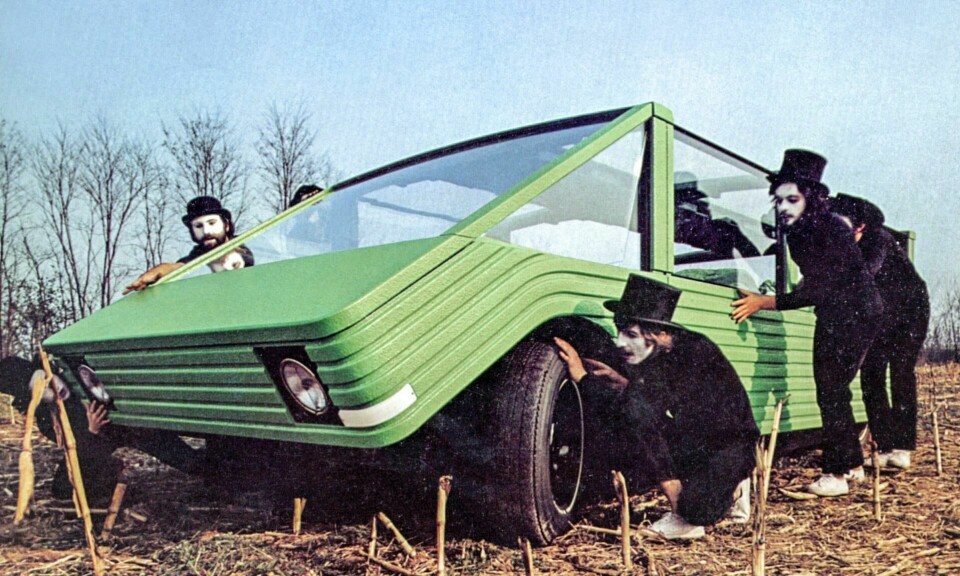
Concept Car of the Week: The Kar-A-Sutra (1972)
Bizarre, hideous, yet enormously influential
In 1972 the Museum of Modern Art (MOMA) in New York held an exhibition: Italy: The New Domestic Landscape. A number of avant-garde Italian architects and designers were invited to submit work for what would become one of the seminal exhibitions of the decade.
When Milanese product designer and architect Mario Bellini was approached by curator Emilio Ambasz and asked to submit an entry, it didn’t take him long to find a subject to explore. Bellini was increasingly alarmed at the damage being wrought on his hometown of Milan by the thousands of smoke-belching cars crowding the city centre each day. It was an unsustainable situation, one that Bellini hoped to overcome by rethinking the car.

The automobile that Bellini proposed was a boxy monovolume 4880mm long and 1980mm wide. It had an odd shape with no discernible refinement in proportions. Its interior was a seatless assortment of cushions inside a large greenhouse. It was the Kar-A-Sutra, a salaciously-named challenge to all conventions embraced by automotive designers.

The Kar-A-Sutra was designed from the inside out, as Bellini tried to “make the car a mobile human space.” The primacy of the driver was removed in favour of an open space for gathering, eating, or sleeping or other “pleasurable” communal activities. There were no seats, but an assortment of cushions made from a first-generation memory foam. The cushions could be rearranged at will to form all manner of seating or sleeping surfaces. A continuous thin storage container ringed the passenger compartment so that items could be stored away.

The glasshouse could be raised from its sleek touring height of 1200mm to a full 2150mm, allowing for an enormous greenhouse and voluminous interior space. Additionally, roof and window glazing could be removed to allow the Kar-A-Sutra to take on the character of an enormous convertible or an outdoor pavilion.

The exterior was a direct expression of the interior – a glazed box on four wheels. The sides were raked with character lines than emphasized the horizontality of the composition, especially with the glasshouse in touring mode, where it most closely resembled its conceptual predecessor, the American station wagon.

The Kar-A-Sutra project wasn’t just an artist’s model of a car that might be; it had some real-world underpinnings. Its undercarriage was from a DS donated by Citroën. Pirelli and the furniture manufacturer Cassina assisted in fitting out the interior and designing the cushions and surfaces. In theory, the car actually ran, although there’s some dispute as to whether everything was connected and the car actually driven.

Even the official Kar-A-Sutra photoshoot challenged conventions. Instead of a few leggy fashion models attending the car in an exotic location, the Sutra was pictured in the spiky remains of a freshly harvested cornfield, with a troupe of creepy-looking mimes showing the Sutra’s various interior arrangements. The resulting photos cemented the car’s outré reputation. It was a perfect anti-presentation for the ultimate anti-car.

If story thus far has you wondering just how the Kar-A-Sutra addressed the problems of the car and the city, the short answer was that Bellini never intended it to. Bellini felt mass transit options were necessary for travel in the city, and the Kar-A-Sutra was meant to be part of a car sharing service that would allow fun and flexible travel at the seaside, in the mountains, or for motorway travel between metropolitan regions. It may have been the first proposal ever for a car sharing service.

As a conceptual project, the Kar-A-Sutra was one of the most successful concept cars. Its design questioned everything understood about a car ownership, seating, space usage, packaging, and even presentation. It opened up the conversation about what a car could and must be – a conversation that has been given new currency with the advancement of autonomous car technologies. In the interim, it allowed for the MPV to emerge, and the Kar-A-Sutra has been said to have influenced the design of the original Renault Espace, as well as many others.

As for its designer, now in his eighties, Mario Bellini still presides, with his son, over a large architectural and industrial design practice in his hometown of Milan. He now claims to be the Father of the MPV.






















